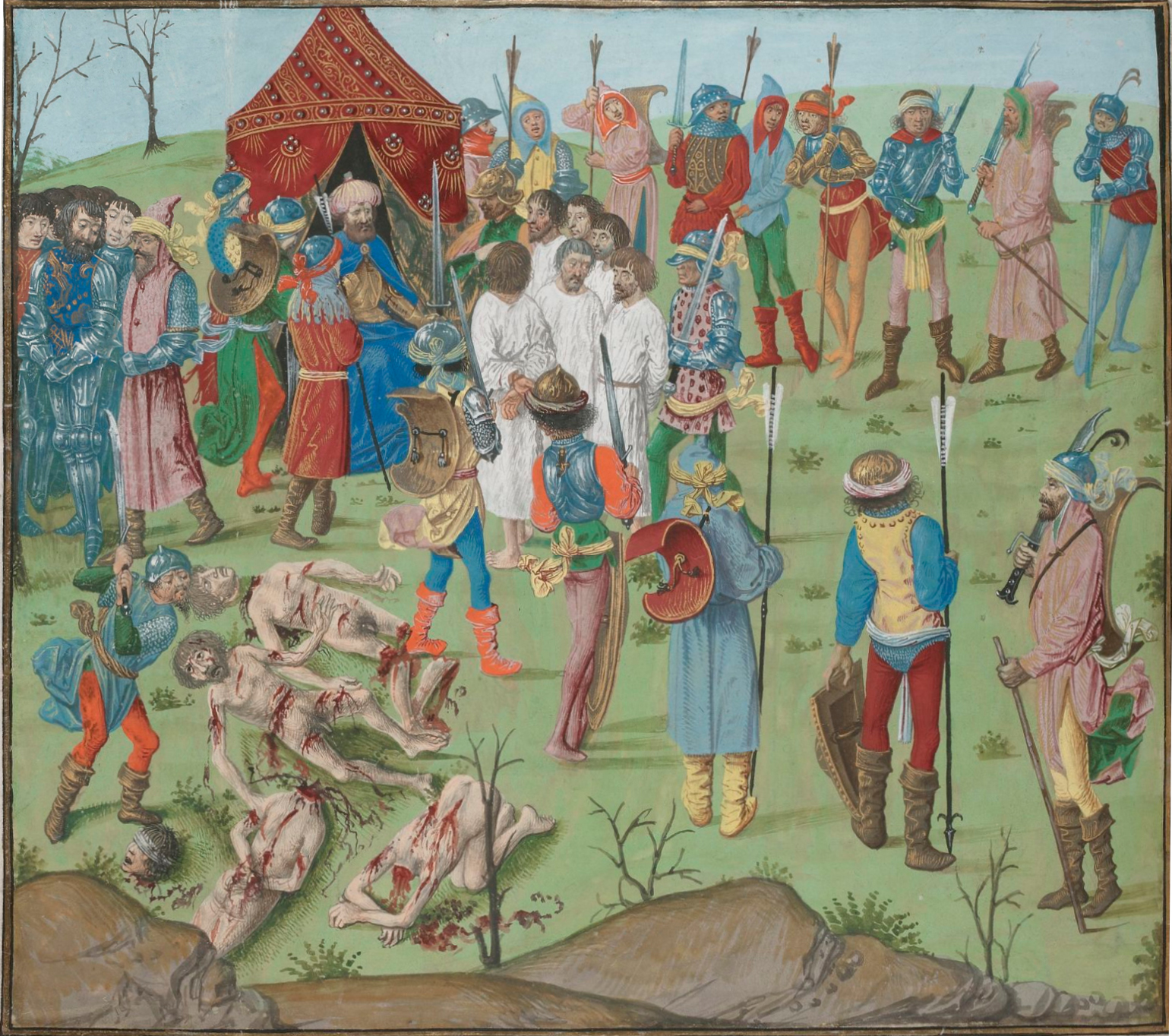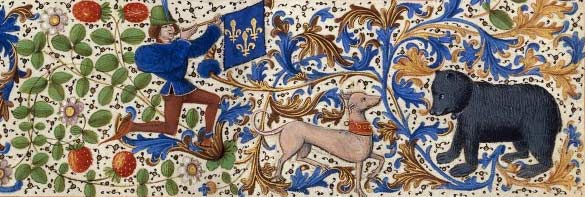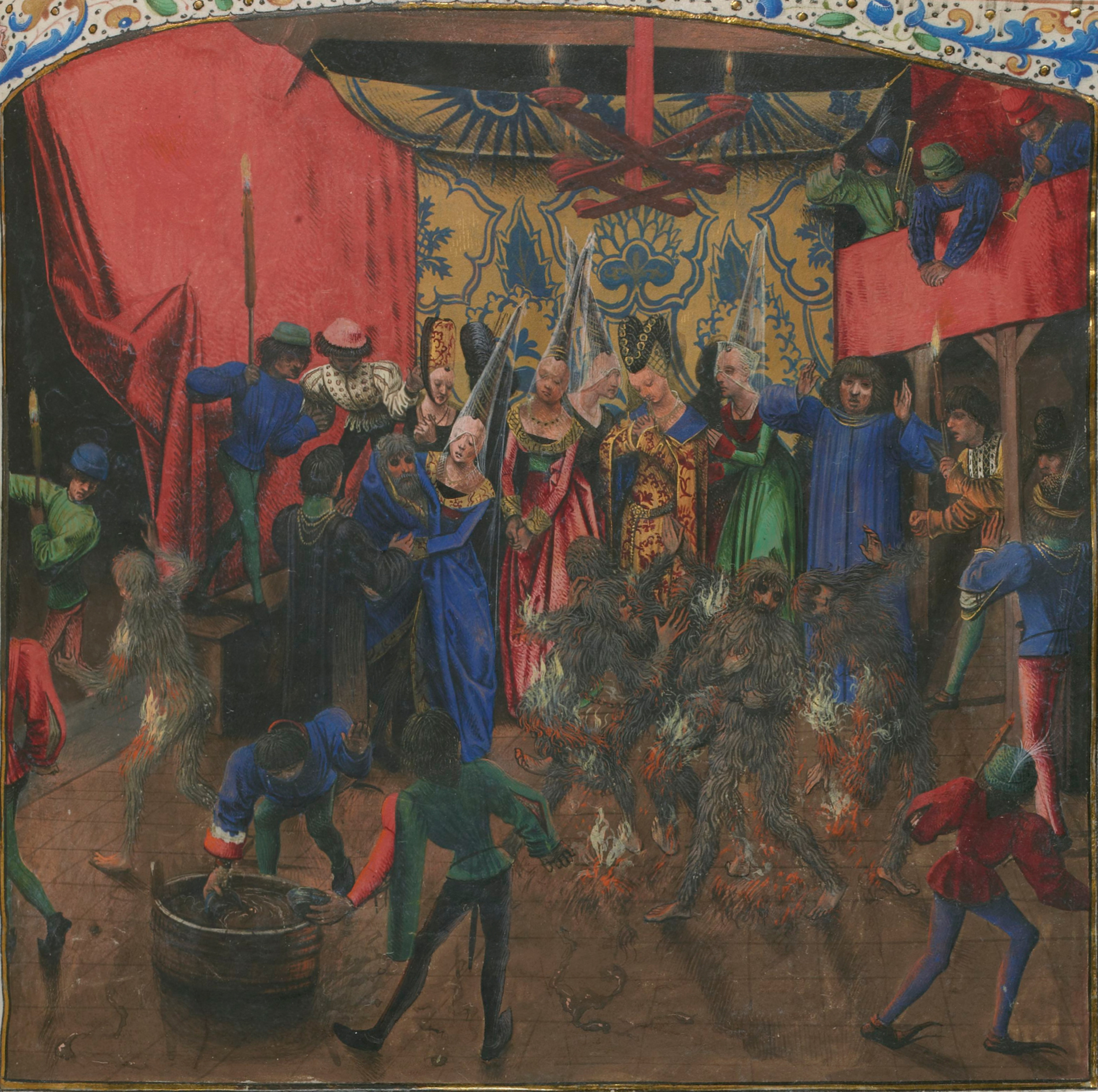Froissart of Louis of Gruuthuse (BnF Fr 2643-6) on:
[Wikipedia]
[Google]
[Amazon]

 The Froissart of Louis of Gruuthuse (BnF Fr 2643–6) is a heavily illustrated deluxe illuminated manuscript in four volumes, containing a French text of Froissart's ''Chronicles'', written and illuminated in the first half of the 1470s in
The Froissart of Louis of Gruuthuse (BnF Fr 2643–6) is a heavily illustrated deluxe illuminated manuscript in four volumes, containing a French text of Froissart's ''Chronicles'', written and illuminated in the first half of the 1470s in

File:BNMsFr2643FroissartFol97vExecHughDespenser.jpg, Execution of
volume 1volume 2volume 3volume 4''The Master of the Dresden Prayer Book'' at Getty Museum
{{DEFAULTSORT:Froissart Of Louis Of Gruuthuse (Bnf Fr 2643-6) Illuminated histories Hundred Years' War literature Arts in the court of Philip the Good Bibliothèque nationale de France collections 15th-century illuminated manuscripts

 The Froissart of Louis of Gruuthuse (BnF Fr 2643–6) is a heavily illustrated deluxe illuminated manuscript in four volumes, containing a French text of Froissart's ''Chronicles'', written and illuminated in the first half of the 1470s in
The Froissart of Louis of Gruuthuse (BnF Fr 2643–6) is a heavily illustrated deluxe illuminated manuscript in four volumes, containing a French text of Froissart's ''Chronicles'', written and illuminated in the first half of the 1470s in Bruges
Bruges ( , nl, Brugge ) is the capital and largest city of the province of West Flanders in the Flemish Region of Belgium, in the northwest of the country, and the sixth-largest city of the country by population.
The area of the whole city a ...
, Flanders
Flanders (, ; Dutch: ''Vlaanderen'' ) is the Flemish-speaking northern portion of Belgium and one of the communities, regions and language areas of Belgium. However, there are several overlapping definitions, including ones related to cultu ...
, in modern Belgium. The text of Froissart's ''Chronicles'' is preserved in more than 150 manuscript copies. This is one of the most lavishly illuminated examples, commissioned by Louis of Gruuthuse, a Flemish
Flemish (''Vlaams'') is a Low Franconian dialect cluster of the Dutch language. It is sometimes referred to as Flemish Dutch (), Belgian Dutch ( ), or Southern Dutch (). Flemish is native to Flanders, a historical region in northern Belgium; ...
nobleman and bibliophile. Several leading Flemish illuminators worked on the miniatures.
The four volumes are now in the Bibliothèque nationale de France in Paris as BnF, MSS Français 2643–6, and contain 110 miniatures of various sizes painted by some of the best artists of the day. The page size is approximately 44 × 33 cm, with miniatures of various sizes, from three-quarter–page and half-page, to historiated initial
A historiated initial is an initial, an enlarged letter at the beginning of a paragraph or other section of text, that contains a picture. Strictly speaking, a historiated initial depicts an identifiable figure or a specific scene, while an in ...
s. The French text is in two columns and there is extensive marginal decoration of scrolling stems and other plant motifs, with some human and animal figures among them.
Artists

Loyset Liédet
Loyset Liédet (1420 – after 1479, or after 1484), was a Flemish miniaturist and illuminator, running a workshop which may have been of some size. Although he was very successful, and patronized by the leading collectors of his day, his work ...
produced the sixty miniatures in the first two volumes. He was a very successful, if somewhat formulaic, illuminator, working mainly on secular manuscripts for Philip III, Duke of Burgundy
Philip III (french: Philippe le Bon; nl, Filips de Goede; 31 July 1396 – 15 June 1467) was Duke of Burgundy from 1419 until his death. He was a member of a cadet line of the Valois dynasty, to which all 15th-century kings of France belonged ...
(Philip the Good) and his court. He probably used assistants, but it is hard to detect separate hands in his work.
The last two volumes, which are in general finer, were worked on by the anonymous illuminators known as the Master of Anthony of Burgundy (identified by some writers with Philippe de Mazerolles), the Master of Margaret of York, and the Master of the Dresden Prayer Book, the last as an assistant to the Master of Anthony of Burgundy. These masters are named after prominent works or patrons of theirs. It appears that the project was split in half from an early stage, as the scribes who wrote the text and the style of border decoration (also the work of specialists) differ between volumes 1–2 and 3–4.
The large miniatures by the Master of Anthony of Burgundy are especially sophisticated in style, and those by the young Master of the Dresden Prayer Book (above) are notable for "their startlingly ambitious palette and combination of colors, agitated and vibrantly modelled drapery, an apparently inexhaustible range of well-designed figure poses, and challenging placement of figures within complex spaces" (McKendrick). All the illustrations below are from the first two volumes, unless otherwise stated.
Patron
Louis of Gruuthuse (1427–1492) was born and lived in Bruges and was an important member of the court of Philip the Good. He appears to have been the second largest purchaser in the period, after Philip himself, of illuminated manuscripts from the best Flemish workshops, then at the peak of their success. He had a book collection totalling about 190 volumes, mostly secular in content, of which over half were contemporary illuminated copies. This made his collection over twice the size of the contemporary English royal collection. Louis was in fact one of the last people to commission new manuscripts on such a scale; he probably began collecting books in the late 1460s, with many of his major commissions dating from the 1470s. In some cases even from that decade the titles already existed in printed form, and by the end of his life most titles could be bought printed, and Flemish illumination, especially of secular works, was in deep decline. Froissart's ''Chronicles'' were not printed until about 1498, in Paris. He incorporated portraits of himself in miniatures in several books (but not these volumes); an extra figure, wearing the collar of the Order of the Golden Fleece, appears in his copies but not in similar compositions in other copies of the same works.T. Kren & S. McKendrick (eds), ''Illuminating the Renaissance: The Triumph of Flemish Manuscript Painting in Europe'', pp. 68 & 266 Getty Museum/Royal Academy of Arts, 2003, Many of his volumes, like this set, passed to King Louis XII of France, and are now in the Bibliothèque nationale de France. King Louis painted his arms over those of Louis de Gruuthuse on some pages in this set (and in other books had the Burgundian collar of the Fleece over-painted on the de Gruuthuse figures). The current bindings are later (17th or 18th century), but traces of what were probably the original blue velvet bindings remain. Like the "Harley Froissart" (British Library
The British Library is the national library of the United Kingdom and is one of the largest libraries in the world. It is estimated to contain between 170 and 200 million items from many countries. As a legal deposit library, the British ...
Harley MSS 4379–4380), which is the most fully illustrated of all illuminated Froissarts, this is an example of a notable resurgence of interest in Froissart's work from the late 1460s onwards; the earliest parts of the ''Chronicles'' were by then over a century old, and covered a period beginning 140 years before.
Gallery
All miniatures are by Loyset Liédet, unless stated. Dates are of the events, not the miniatures.Hugh the younger Despenser
Hugh le Despenser, 1st Baron le Despenser (c. 1287/1289 – 24 November 1326), also referred to as "the Younger Despenser", was the son and heir of Hugh le Despenser, Earl of Winchester (the Elder Despenser), by his wife Isabella de Beauchamp ...
in Hereford, 1326
File:BattleofSluys.jpeg, Battle of Sluys
The Battle of Sluys (; ), also called the Battle of l'Écluse, was a naval battle fought on 24 June 1340 between England and France. It took place in the roadstead of the port of Sluys (French ''Écluse''), on a since silted-up inlet between ...
, 1340
File:Battle of crecy froissart.jpg, Battle of Crécy
The Battle of Crécy took place on 26 August 1346 in northern France between a French army commanded by King PhilipVI and an English army led by King EdwardIII. The French attacked the English while they were traversing northern France du ...
, 1346
File:BNMsFr2643FroissartFol97vBatNevilleCross.jpg, Battle of Neville's Cross
The Battle of Neville's Cross took place during the Second War of Scottish Independence on 17 October 1346, half a mile (800 m) to the west of Durham, England. An invading Scottish army of 12,000 led by King David II was defeated with heavy los ...
, 1346. English victory over the Scots outside Durham Durham most commonly refers to:
*Durham, England, a cathedral city and the county town of County Durham
*County Durham, an English county
* Durham County, North Carolina, a county in North Carolina, United States
*Durham, North Carolina, a city in N ...
.
File:Death of Wat Tyler Froissart.jpg, Death of Wat Tyler
Wat Tyler (c. 1320/4 January 1341 – 15 June 1381) was a leader of the 1381 Peasants' Revolt in England. He led a group of rebels from Canterbury to London to oppose the institution of a poll tax and to demand economic and social reforms. Wh ...
, leader of the Peasants' Revolt
The Peasants' Revolt, also named Wat Tyler's Rebellion or the Great Rising, was a major uprising across large parts of England in 1381. The revolt had various causes, including the socio-economic and political tensions generated by the Blac ...
, in London, 1381
File:Nicopol final battle 1398.jpg, Battle of Nicopolis, 1396, by the Master of the Dresden Prayer Book
Notes
References
*T. Kren & S. McKendrick (eds.), ''Illuminating the Renaissance: The Triumph of Flemish Manuscript Painting in Europe'', No. 71, pp. 268–71 Getty Museum/Royal Academy of Arts, 2003,External links
* *Digitised manuscript from the Bibliothèque nationale de Francevolume 1
{{DEFAULTSORT:Froissart Of Louis Of Gruuthuse (Bnf Fr 2643-6) Illuminated histories Hundred Years' War literature Arts in the court of Philip the Good Bibliothèque nationale de France collections 15th-century illuminated manuscripts